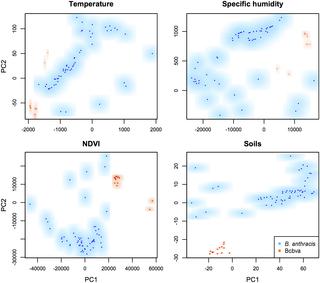当前位置:
X-MOL 学术
›
PLOS Negl. Trop. Dis.
›
论文详情
Our official English website, www.x-mol.net, welcomes your
feedback! (Note: you will need to create a separate account there.)
Potential distributions of Bacillus anthracis and Bacillus cereus biovar anthracis causing anthrax in Africa.
PLOS Neglected Tropical Diseases ( IF 3.4 ) Pub Date : 2020-03-09 , DOI: 10.1371/journal.pntd.0008131 Daniel Romero-Alvarez 1 , A Townsend Peterson 1 , Johanna S Salzer 2 , Claudia Pittiglio 3 , Sean Shadomy 3, 4 , Rita Traxler 2 , Antonio R Vieira 2 , William A Bower 2 , Henry Walke 2 , Lindsay P Campbell 5
PLOS Neglected Tropical Diseases ( IF 3.4 ) Pub Date : 2020-03-09 , DOI: 10.1371/journal.pntd.0008131 Daniel Romero-Alvarez 1 , A Townsend Peterson 1 , Johanna S Salzer 2 , Claudia Pittiglio 3 , Sean Shadomy 3, 4 , Rita Traxler 2 , Antonio R Vieira 2 , William A Bower 2 , Henry Walke 2 , Lindsay P Campbell 5
Affiliation

|
BACKGROUND
Bacillus cereus biovar anthracis (Bcbva) is an emergent bacterium closely related to Bacillus anthracis, the etiological agent of anthrax. The latter has a worldwide distribution and usually causes infectious disease in mammals associated with savanna ecosystems. Bcbva was identified in humid tropical forests of Côte d'Ivoire in 2001. Here, we characterize the potential geographic distributions of Bcbva in West Africa and B. anthracis in sub-Saharan Africa using an ecological niche modeling approach.
METHODOLOGY/PRINCIPAL FINDINGS
Georeferenced occurrence data for B. anthracis and Bcbva were obtained from public data repositories and the scientific literature. Combinations of temperature, humidity, vegetation greenness, and soils values served as environmental variables in model calibrations. To predict the potential distribution of suitable environments for each pathogen across the study region, parameter values derived from the median of 10 replicates of the best-performing model for each pathogen were used. We found suitable environments predicted for B. anthracis across areas of confirmed and suspected anthrax activity in sub-Saharan Africa, including an east-west corridor from Ethiopia to Sierra Leone in the Sahel region and multiple areas in eastern, central, and southern Africa. The study area for Bcbva was restricted to West and Central Africa to reflect areas that have likely been accessible to Bcbva by dispersal. Model predicted values indicated potential suitable environments within humid forested environments. Background similarity tests in geographic space indicated statistical support to reject the null hypothesis of similarity when comparing environments associated with B. anthracis to those of Bcbva and when comparing humidity values and soils values individually. We failed to reject the null hypothesis of similarity when comparing environments associated with Bcbva to those of B. anthracis, suggesting that additional investigation is needed to provide a more robust characterization of the Bcbva niche.
CONCLUSIONS/SIGNIFICANCE
This study represents the first time that the environmental and geographic distribution of Bcbva has been mapped. We document likely differences in ecological niche-and consequently in geographic distribution-between Bcbva and typical B. anthracis, and areas of possible co-occurrence between the two. We provide information crucial to guiding and improving monitoring efforts focused on these pathogens.
中文翻译:

引起炭疽病的炭疽芽孢杆菌和蜡状芽孢杆菌炭疽生物变种在非洲的潜在分布。
背景蜡状芽孢杆菌炭疽生物变种(Bcbva)是一种新出现的细菌,与炭疽病原菌炭疽芽孢杆菌密切相关。后者在世界范围内分布,通常会引起与稀树草原生态系统相关的哺乳动物的传染病。Bcbva 于 2001 年在科特迪瓦的潮湿热带森林中被发现。在这里,我们使用生态位建模方法描述了 Bcbva 在西非和炭疽杆菌在撒哈拉以南非洲的潜在地理分布。方法/主要发现 炭疽芽孢杆菌和 Bcbva 的地理参考发生数据是从公共数据存储库和科学文献中获得的。温度、湿度、植被绿度和土壤值的组合作为模型校准中的环境变量。为了预测研究区域内每种病原体的适宜环境的潜在分布,使用了从每种病原体的最佳表现模型的 10 次重复中值得出的参数值。我们在撒哈拉以南非洲已确诊和疑似炭疽活动的地区发现了预计炭疽芽孢杆菌适宜生长的环境,包括萨赫勒地区从埃塞俄比亚到塞拉利昂的东西走廊以及非洲东部、中部和南部的多个地区。Bcbva 的研究区域仅限于西非和中非,以反映 Bcbva 可能通过扩散进入的区域。模型预测值表明潮湿森林环境中潜在的合适环境。当比较炭疽杆菌与 Bcbva 相关环境以及单独比较湿度值和土壤值时,地理空间中的背景相似性测试表明统计支持拒绝相似性的零假设。在将 Bcbva 相关环境与炭疽芽孢杆菌相关环境进行比较时,我们未能拒绝相似性的零假设,这表明需要进行额外的研究来提供 Bcbva 生态位的更可靠的表征。结论/意义 本研究首次绘制了 Bcbva 的环境和地理分布图。我们记录了 Bcbva 和典型炭疽芽孢杆菌之间生态位的可能差异,以及由此产生的地理分布差异,以及两者之间可能共存的区域。我们提供对于指导和改进针对这些病原体的监测工作至关重要的信息。
更新日期:2020-03-10
中文翻译:

引起炭疽病的炭疽芽孢杆菌和蜡状芽孢杆菌炭疽生物变种在非洲的潜在分布。
背景蜡状芽孢杆菌炭疽生物变种(Bcbva)是一种新出现的细菌,与炭疽病原菌炭疽芽孢杆菌密切相关。后者在世界范围内分布,通常会引起与稀树草原生态系统相关的哺乳动物的传染病。Bcbva 于 2001 年在科特迪瓦的潮湿热带森林中被发现。在这里,我们使用生态位建模方法描述了 Bcbva 在西非和炭疽杆菌在撒哈拉以南非洲的潜在地理分布。方法/主要发现 炭疽芽孢杆菌和 Bcbva 的地理参考发生数据是从公共数据存储库和科学文献中获得的。温度、湿度、植被绿度和土壤值的组合作为模型校准中的环境变量。为了预测研究区域内每种病原体的适宜环境的潜在分布,使用了从每种病原体的最佳表现模型的 10 次重复中值得出的参数值。我们在撒哈拉以南非洲已确诊和疑似炭疽活动的地区发现了预计炭疽芽孢杆菌适宜生长的环境,包括萨赫勒地区从埃塞俄比亚到塞拉利昂的东西走廊以及非洲东部、中部和南部的多个地区。Bcbva 的研究区域仅限于西非和中非,以反映 Bcbva 可能通过扩散进入的区域。模型预测值表明潮湿森林环境中潜在的合适环境。当比较炭疽杆菌与 Bcbva 相关环境以及单独比较湿度值和土壤值时,地理空间中的背景相似性测试表明统计支持拒绝相似性的零假设。在将 Bcbva 相关环境与炭疽芽孢杆菌相关环境进行比较时,我们未能拒绝相似性的零假设,这表明需要进行额外的研究来提供 Bcbva 生态位的更可靠的表征。结论/意义 本研究首次绘制了 Bcbva 的环境和地理分布图。我们记录了 Bcbva 和典型炭疽芽孢杆菌之间生态位的可能差异,以及由此产生的地理分布差异,以及两者之间可能共存的区域。我们提供对于指导和改进针对这些病原体的监测工作至关重要的信息。











































 京公网安备 11010802027423号
京公网安备 11010802027423号